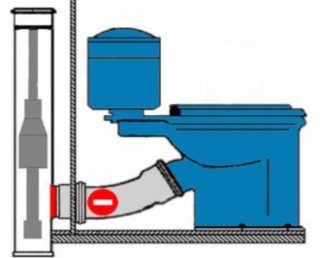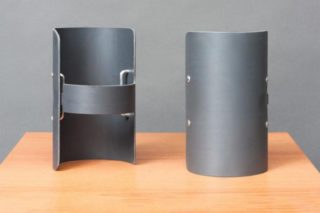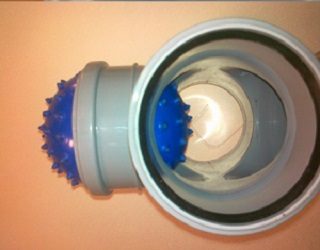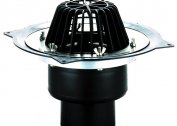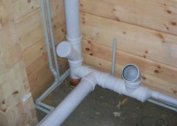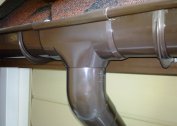Sewer plug - a device that covers the entire riser or its individual branches. Sewage pipes are blocked in whole or in part - only solid waste is retained. You can install a shut-off product both at the stage of primary laying of the sewage system, and during its operation.
Purpose of a cap for a sewer pipe
Plugs are made of metal, plastic and rubber. Polypropylene products, models made of PVC and cast iron are very popular. Many locking devices have a smooth surface, which prevents the accumulation of body fat from the riser side.
The installation of a valve or other locking device is carried out unscheduled or in advance. The procedure is aimed at achieving the following goals:
- completely block part of the riser for repair or partial replacement;
- block the lumen of the channel to drain and clean the clogged area;
- connect the drain hoses of sinks and household appliances;
- inspect and service the joints of pipes of different diameters;
- block drains during the scheduled repair of the riser at the entrance of the apartment wiring.
The legality of the installation of the plug is confirmed by Art. 21 Federal Law No. 416 of 12/07/2011
Operating principle
Plugs are installed at the entry points of the sewer branches from the riser to the apartment. Since on average 1 person produces up to 100-150 liters of liquid waste per day, from the installed barrier to the riser, the water will rise quite quickly. As a result, residents will not be able to use plumbing fixtures in the kitchen, in the bathroom and in the toilet.
Sewer obstacles are installed in such a way as to drown out the system of drainage of defaulters. Sewage channels of neighboring apartments are not affected.
Types of Stubs
 The drainage system of residential buildings is laid underground and consists of pipes of various diameters. For household sewage, this indicator is usually 110 mm. In places of the alleged creation of additional branches, wiring is performed. Outlets that are not used are blocked by plugs.
The drainage system of residential buildings is laid underground and consists of pipes of various diameters. For household sewage, this indicator is usually 110 mm. In places of the alleged creation of additional branches, wiring is performed. Outlets that are not used are blocked by plugs.
Locking elements of the sewerage are classified into several types:
- Permanent. Their installation is carried out for a long time. Such designs are installed for several months or years. Usually used if a complete sewage system is formed. At certain points in the pipeline, bends and tees are installed. In the future they are used to connect new objects. Permanent plugs are made of high quality polymer or metal. Typically, such elements are represented by a convex shaped lid. Seals are placed inside the devices to seal the structure and reduce pressure on it. Many permanent plugs are threaded.
- Temporary. Provide short-term restrictions in the functional element of the sewage system. Outwardly, they resemble permanent stubs. The need for temporary plugs appears when creating an additional riser in the apartment.
- Inflatable. To install them, use a special device equipped with a long hose. Pneumatic plug for sewer pipes (ROM) is represented by a rubber ball with teeth, which is connected to the sleeve. On the hose there is a camera and several handles, due to which it is convenient to use. The inflatable plug is lowered into the riser, usually through the top access point on the roof.The presence of a camera allows the operator to inspect the internal contents of the pipeline, so that you can quickly determine the place where to install the multi-sized pneumatic plug.
- Mechanical. The locking elements of this type are equipped with shields and have a complex structure. Install such plugs in a certain sequence - prepare a hose with a camera, place the plug in the riser, then push it to the right place and give an electrical signal to unfold the element. After installation, the device shields are fixed on the walls, which provides automatic blocking of the outlet. Typically, mechanical products are represented by plastic plugs for sewer pipes.
Blocking devices "Octopus" is often used to close sewer branches for non-payment. A video camera is built into this type of device. Using this equipment, you can plug the pipe partially or completely. In the first case, specialists configure the system.
Onyx plugs are a comprehensive system consisting of a sleeve and a probe. The latter is set using the manipulator. In the housing of the locking device there are LEDs and a video camera.
Polytron plugs for internal and external sewerage are used for temporary or permanent blocking of the open ends of pipes. They are made of polypropylene.
Mounting Features
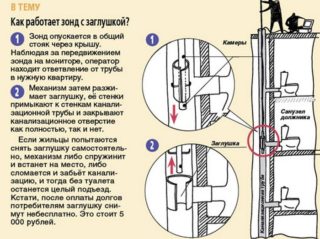 When the employees of the service organization have taken all measures to eliminate the debt for utilities (sending appropriate notifications), a sewer can be installed on the non-payer. It is mounted in such a way as not to cause discomfort to other residents of the apartment building.
When the employees of the service organization have taken all measures to eliminate the debt for utilities (sending appropriate notifications), a sewer can be installed on the non-payer. It is mounted in such a way as not to cause discomfort to other residents of the apartment building.
For the correct installation of the blocking element, you need:
- manipulator;
- camcorder with remote control;
- fiber-optic wire providing design illumination.
The plug in the sewer is installed in the following sequence:
- To study the structure of the drainage system, to understand what material it is made of, to check for the presence of additional runoff from the deadbeat apartment.
- Determine the mounting location of the locking device. Install it using an intra-apartment pipe leading from the toilet to the common riser.
- Find the entry point from which the equipment will be launched into the system. For this purpose, a fan pipe located on the roof is used.
- Insert the manipulator into the water channel and gradually lower it down. The camera fixed on it allows you to find the installation location.
- When the mounting point of the blocking element is reached, lower the plug and insert it on the side of the apartment drain.
- Lock the plug.
To install a sewage blocker, it is necessary to undergo training, so this work is done only by employees of the housing and communal services or a service company.
Methods for Removing a Fixture
Removing the toilet is one of the effective ways to remove the plug. It will be practical if the toilet has a modern hygiene product, bolted to the floor. Old versions are filled with cement, so it’s better not to touch them, otherwise further installation in place will be impossible.
Before removing the toilet, you must:
- shut off water;
- remove the tank and turn off communications;
- unscrew the bolts securing the ceramic element and disassemble the socket before the first connection;
- gently pull the plug into the apartment using pliers;
- put the toilet in place and connect the communications.
Do not push the locking device into the riser. This will lead to clogging of the pipeline and the appearance of problems with sewage in the entire house. You can’t apply too much effort to remove the obstacle, especially if the cast iron riser — it can not withstand large mechanical loads.
To remove the plug through the dismantling of the toilet, you need to prepare wrenches, an adjustable wrench, a flashlight, gloves and pliers. The hammer and the expansion bolt shield can be useful.
Audit
Revision is a kind of tee that allows you to clean the riser if necessary. In order to tear off the plug through it, it is important to prepare a stick with a hook in advance.
The process of dismantling the locking element:
- open the lid of the revision;
- stick a stick or harpoon into the riser;
- hook the plug and pull it towards you.
During removal of the obstacle, you must be in gloves and tight clothing so that accidental discharge of water (possibly boiling water) does not harm your health. The main disadvantage of this method is that the work is carried out blindly.
Other methods
Features of the elimination of the plug depends on its type and material of manufacture:
- If the product is rubber, it is easy to pierce it with any cutting object. A plumbing cable and a sharp tool are lowered into the pipe. The cut ball is deflated and eliminated from the system.
- If the blocking product needs to be removed to the owner of the apartment on the top floor, he can access the pipes through the attic or roof.
- It is allowed to remove the plug with chemicals containing hydrochloric or oxalic acid. The main disadvantage of this method is the high probability of damage to the pipes themselves. In addition, it is characterized by low efficiency. Chemical reagents begin to act several days after the start of use.
Sewer plugs are effective tools for blocking the riser in an emergency. In order not to be installed by housing and communal services employees, utility bills should be paid on time.
